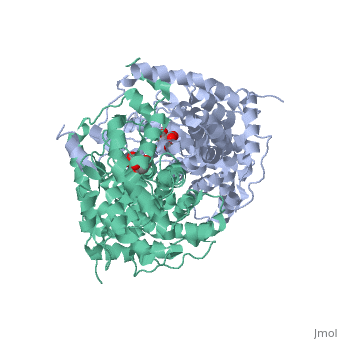Citrate Synthase: Difference between revisions
| Line 1: | Line 1: | ||
==The Structure and Mechanism of Citrate Synthase== | ==The Structure and Mechanism of Citrate Synthase== | ||
<applet load='1cts' size='300' color='white' frame='true' align='right' caption='Citrate Synthase Open Form' name='open'/> | <applet load='1cts' size='300' color='white' frame='true' align='right' caption='Citrate Synthase Open Form' name='open'/> | ||
Citrate synthase is an enzyme active in the mitochondria, where it is responsible for catalyzing the first reaction of the citric acid cycle (Krebs Cycle): the condensation of acetyl-CoA and oxaloacetate to form citrate. | |||
'''Structure:''' Citrate synthase is a single amino acid chain <scene name='Daniel_Eddelman_Sandbox_2/Cts_open_monomer/1'>monomer</scene>. Biologically, however, it exists as a | '''Structure:''' Citrate synthase is a single amino acid chain <scene name='Daniel_Eddelman_Sandbox_2/Cts_open_monomer/1'>monomer</scene>. Biologically, however, it exists as a | ||
| Line 23: | Line 11: | ||
<references/> | |||
< | <applet load='2cts' size='300' color='white' frame='true' align='right' caption='Citrate Synthase Closed Form' name='closed'/> | ||
Revision as of 20:39, 21 March 2010
The Structure and Mechanism of Citrate SynthaseThe Structure and Mechanism of Citrate Synthase
|
Citrate synthase is an enzyme active in the mitochondria, where it is responsible for catalyzing the first reaction of the citric acid cycle (Krebs Cycle): the condensation of acetyl-CoA and oxaloacetate to form citrate.
Structure: Citrate synthase is a single amino acid chain . Biologically, however, it exists as a . Each identical subunit consists of a large and a small domain, and is comprised almost entirely of α helices (making it an all α protein). In its free enzyme state, citrate synthase exists in “open” form, with its two domains forming a cleft containing the substrate (oxaloacetate) binding site (PDB: 1cts) [1]. When oxaloacetate binds, the smaller domain undergoes an 18° rotation, sealing the oxaloacetate binding site and resulting in the (PDB: 2cts). This conformational change not only prevents solvent from reaching the bound substrate, but also generates the acetyl-CoA binding site. This presence of “open” and “closed” forms results in citrate synthase having Ordered Sequential kinetic behavior.
Mechanism: The reaction mechanism for citrate synthase was proposed by James Remington. In this mechanism, three ionizable side chains in the of citrate synthase participate in acid-base catalysis: His 274, His 320, and Asp 375. First, (a base) removes a proton from the methyl group of acetyl-CoA to form its enol. stabilizes the acetyl-CoA enolate by forming a hydrogen bond with the enolate oxygen. The enolate then nucleophilically attacks oxaloacetate’s carbonyl carbon, and donates a proton to oxaloacetate’s carbonyl group in a concerted step, forming citryl-CoA (which remains bound to the enzyme). Finally, citryl-CoA is hydrolyzed to citrate and CoA.
|

